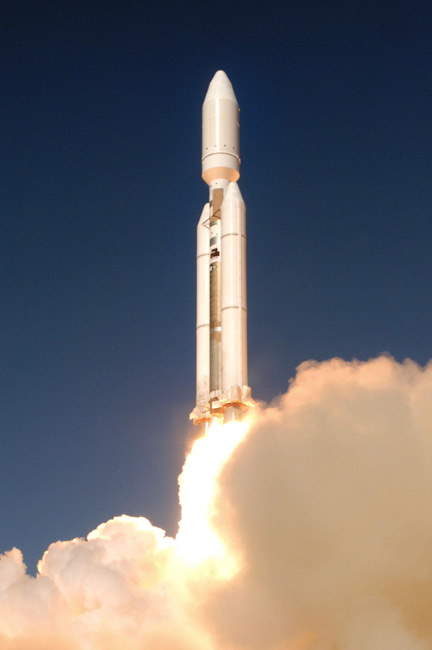Behind the Scenes: Vandenberg Air Force Base

Vandenberg Air Force Base is a sprawling space and missile hub, located on California's Central Coast. It is home base for an evolving story of "missilering" at its best, along with carrying out spacelift operations from the Cold War to today's developments in military, commercial, and scientific space endeavors.
Situated northwest of Los Angeles, the base is larger in acreage than the nearby cities of Lompoc, Santa Maria and Guadalupe combined. Vandenberg supports a population greater than 18,000, comprised of military, family members, contractors, and civilian employees.
Operated by the Air Force Space Command's 30th Space Wing, Vandenberg AFB is the only military base in the United States from which unpiloted government and commercial spacecraft are launched into polar orbit. It is also the only site from which intercontinental ballistic missiles (ICBMs) are routinely test fired into the Pacific Ocean, arcing over sea waters and splashing down at the Kwajalein Atoll within the Marshall Islands.
While rockets roar away from the base, often it's the skies over Vandenberg that also tell the story.
A wispy vapor trail of frozen propellant particles and water from a launch can create a twilight phenomenon. These fragments high in the atmosphere reflect sunlight and yield a colorful show in the sky for viewers on the ground.
Assortment of boosters
The 30th Space Wing conducts critical spacelift and range operations and supports operational and developmental missile system testing for the Department of Defense from the West Coast of the United States.
Breaking space news, the latest updates on rocket launches, skywatching events and more!
"I don't believe in being last at anything," said U.S. Air Force Colonel Jack Weinstein, commander of the 30th Space Wing and the Western Range at Vandenberg Air Force Base. "We do flawless operations," he said, whether the base is lofting things into orbit or carrying out ballistic missile tests.
Vandenberg handles an assortment of expendable booster classes--Delta, Pegasus, Taurus, Minotaur, Atlas and Titan. Also among its duties, Wing personnel support the Service's Minuteman III ICBM Force Development Evaluation programs.
Titan 4: going, going, gone
While rockets undergo revalidation flights at Vandenberg, launch vehicles are also retired from the arsenal.
For example, an unarmed Minuteman III intercontinental ballistic missile departed Vandenberg September 14 on its fourth and final launch this year to ensure the weapon system is operationally effective.
The Minuteman's single unarmed reentry vehicle traveled approximately 4,200 miles (2,600 kilometers) in about one-half hour, plopping into a pre-determined target at the Ronald Reagan Test Site on the Kwajalein Atoll in the western chain of the Marshall Islands.
Weinstein pointed out that Vandenberg is the U.S. platform for polar orbit launches and the only location to conduct ICBM testing without over-flying populated areas.
Then there was the October 19 historical sendoff from Vandenberg of a last of its kind booster--the Titan 4--a powerful "beast of burden" that hauled into orbit a secret payload. "We need to be perfect at that launch," Weinstein emphasized pre-liftoff.
Responding to "responsive space"
"We do about 7,000 range operations a year," Weinstein pointed out. "We run the Western Launch and Test Range which goes up the coast, up to Oregon, down to Baja, California and out to Hawaii," he said.
One big change at the base is having the entire installation--all 99,000 acres--under control of one commander that works space launch activities, as well perform ballistic missile tasks. "That allows us to be responsive when we see something that needs to be tweaked or a process to make better," Weinstein said.
A central theme that's running hot through Air Force strategists is "responsive space" - a need to rapidly and affordably fly space missions. That also suggests "plug and play" spacecraft, capable of fast assembly, launch and checkout in orbit, among other concepts.
"It's really in the eye of the beholder on responsive space," Weinstein said. "I think we're making progress, but it's an evolutionary progress not really revolutionary progress."
Cutting red tape
Weinstein said it's very easy to get focused on the booster going into orbit, "but the tail in order to do that is really huge." Responsive space also means cutting red tape to see blue sky, in terms of lessening paperwork requirements when you come to any launch range, he said.
"Cut that down by 400 percent...that helps you get responsive," Weinstein added.
Additionally, part of the answer to responsive space is small payloads. "That's where the future is, Weinstein suggested. "When you look at the cost of putting a satellite up that's as big as a Greyhound bus, it takes a long time. They are very expensive...and we don't build backup satellites."
While reaching out to be a 100 percent effective in rocketing payloads into space--even though launch teams push for that--failures can occur, Weinstein said. "By having smaller payloads, I really believe that's one of the keys to being responsive."
The U.S. drive to take part in the global war on terrorism, and protect America, would benefit greatly from having a responsive capability when a crisis comes up, Weinstein explained.
Yet another component of responsive space, Weinstein suggested, is using current capability in new ways. Legacy hardware in orbit, for example, can become more responsive to the warfighter via use of state-of-the-art ground computers and software, he said.
Progressive history
The history books show the site to be an area of progression. For instance, on October 5, 1941 Camp Cooke, the future site of Vandenberg Air Force Base near Lompoc, California, was activated as an armored and infantry division training installation for the U.S. Army.
Just one year to the day after the former Soviet Union's Sputnik 1 reached orbit, Cooke Air Force Base was redesignated Vandenberg AFB, honoring the late General Hoyt S. Vandenberg, the Air Force's second Chief of Staff.
Just two months later, the first missile launch from Vandenberg AFB, a Thor intermediate range ballistic missile (IRBM), took flight from the area. And on February 28, 1959, the world's first polar orbiting satellite--Discoverer 1--as launched using the first Thor/Agena booster/upper stage combination from Vandenberg AFB.
Today the 30th Space Wing is in a state of transition, as is Vandenberg overall.
"The piece that we really need to work has to do with rejuvenating the workforce," Weinstein said. "The average age of our folks is pretty up there," he said, with outreach into the local universities now underway to help address the issue.
New home on the old range
Another action item at the base is modernization. Equipment is old and tough to maintain.
"We'll be moving things out of our old range to new range operations," Weinstein said. A reinvigorated aerospace control center this December will permit speedier reconfiguring of radars, also making simultaneous operations possible, contrasted to sequential operations of the day, he said.
Increased use of the constellation of Global Positioning System (GPS) satellites to help track boosters is also on tap, Weinstein pointed out. Planning is underway to turn an old Titan 2 launch site into a responsive facility, capable of supporting a multitude of vehicles, he said.
"The range was initially developed for sustainability, more than it was for modernization," Weinstein remarked. "During my tenure here, I want to aggressively activate the new test range. That will bring us a lot of capability...so having that new range is really critical to us."
Rocket science
Part of Vandenberg's long lineage of pioneering launches includes support of commercial providers, Weinstein said. "Everyone that comes to Vandenberg is treated equally and it's based on launch manifest, as well as who is ready at the time to launch."
"What you find out from the launch business," Weinstein continued, "it is rocket science. It is very tough and very demanding to do."
For Weinstein and his new command at Vandenberg it's a bit of dejà vu all over again. He first drove through the gates of the base back in late 1982, as a second lieutenant going to missile school. "I couldn't have planned it this way," he said.
Glancing back at all the rocket launches he's viewed over the years, is Weinstein jaded about watching boosters take to the sky?
"When I give the clear to launch poll...my blood pressure is a little high. The adrenalin is flowing. Watching the team put something into space. It's inspiring. I love it," Weinstein said. "To be honest, I'm like a little kid on launch. I think it's one of the coolest things we do."
Join our Space Forums to keep talking space on the latest missions, night sky and more! And if you have a news tip, correction or comment, let us know at: community@space.com.

Leonard David is an award-winning space journalist who has been reporting on space activities for more than 50 years. Currently writing as Space.com's Space Insider Columnist among his other projects, Leonard has authored numerous books on space exploration, Mars missions and more, with his latest being "Moon Rush: The New Space Race" published in 2019 by National Geographic. He also wrote "Mars: Our Future on the Red Planet" released in 2016 by National Geographic. Leonard has served as a correspondent for SpaceNews, Scientific American and Aerospace America for the AIAA. He has received many awards, including the first Ordway Award for Sustained Excellence in Spaceflight History in 2015 at the AAS Wernher von Braun Memorial Symposium. You can find out Leonard's latest project at his website and on Twitter.
